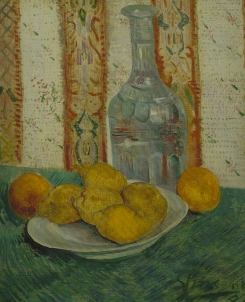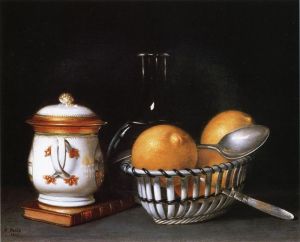European artists have long loved painting lemons
Eduoard Manet, "The Lemon." Manet painted this perfectly simple lemon near the end of his life, in 1880.
Lemons on a Plate and a Carafe, Van Gogh, 1887
Vincent van Gogh painted these lemons when he lived in Arles. I really like that blue-green table with the lines circling round. And the wallpaper. And the carafe. And, of course, the lemons.
Lemons and Saxifrages
Henri Matisse chose a red and white check background for his decorative lemons in 1943. I’m not sure what Saxifrages are.
I think it’s safe to say that no one was more enamored of lemons than the 17th century Dutch still-life painters. They painted them on banquet tables, sometimes with mincemeat pies and oysters, nearly always with wine nearby.
Pieter Claesz liked to paint his lemons reflected on big pewter plates, as in the still life above from around 1625, which I saw at the Chicago Art Institute.
The Dutch liked some lemon peel to flavor their spirits, so you’ll often see lemons near cups of wine, the fruit cut open and half peeled. A great opportunity for those master painters to show off their talents, rendering glistening cut lemons and curling spirals of golden light.
Still Life, 1634
Yesterday I went to the Vancouver Art Gallery to see the exhibit of Dutch art from the Rijksmuseum in Amsterdam, and encountered the stunning picture above by Willem Claesz Heda.
The placard said the lemon represented “moderation.” ?? What were they thinking when they wrote that? I don’t agree at all. If anything, the lemon was just as luxurious as the gold, silver and pewter. Heda painted each light-reflecting object with a loving reverence.
Still life with gilt goblet
Here’s another of Heda’s still life paintings with lemon. He liked to paint the curling ribbon of zest spilling off the table, drawing the viewer’s eye away from the center of the painting.
Alchemists’ work, turning tin and arsenic and vegetable juices into golden fruit painted with a kind of showy complication and variety that suggests there must have been competition among the painters of lemons.
Above is a quote from Mark Doty’s lovely little book, Still Life with Oysters and Lemon, which is both an ode to the still life form and a meditation on ordinary objects and time.
Raphaelle Peale, "Lemons and Sugar," 1822
And let’s not forget the American artist, Raphaelle Peale, who loved to paint the still life — and lemons!







